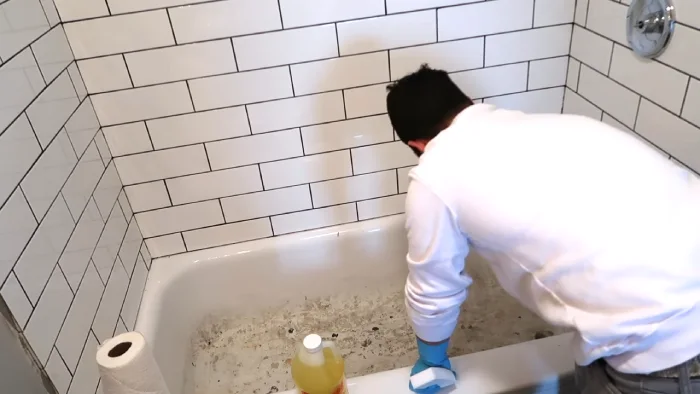Last Updated on July 23, 2023
If you’re tackling a home renovation project, odds are you’ve come face-to-face with the dreaded mortar stuck to your bathtub.
But don’t worry, cleaning it up doesn’t have to be an intimidating experience. With just some simple supplies and steps, both fresh and dried mortar can quickly vanish from your tub.
Grab yourself some microfiber cloth and commercial cleaner for starters. Then block off the drain path before wiping away any excess wet mortar. Once cleaned up, use your cleaning solution all over for an extra deep cleanse.
For dried mortar, just popping off those blobs using a plastic scraper will do wonders. Vacuum up what’s remaining afterward, too. Rinse everything down after applying cleaning solutions. Finish by drying gently with one of those soft clothes.
Let us now provide you with more details on how best to remove all kinds of old/dried-out mortars from peaceably lingering around in there.
How to Clean Mortar Off Bathtub: DIY Steps
Got some fresh mortar hanging out in your bathtub? Don’t stress. Just follow these easy steps for a quick fix, and you’ll return to relaxation mode in no time.
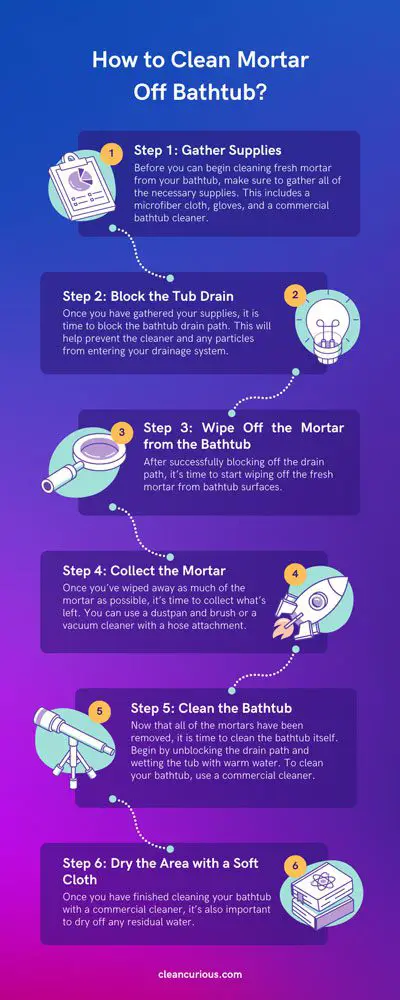
Step 1: Gather Supplies
Before you can begin cleaning fresh mortar from your bathtub, make sure to gather all of the necessary supplies. This includes a microfiber cloth, gloves, and a commercial bathtub cleaner.
The microfiber cloth will help you wipe away any debris without causing scratches or other damage. It’s essential to protect your hands with gloves to keep them safe from harsh chemicals that might be present in the cleaner.
Lastly, make sure to use a cleaning product that is specifically formulated for tubs to avoid damaging the surface.
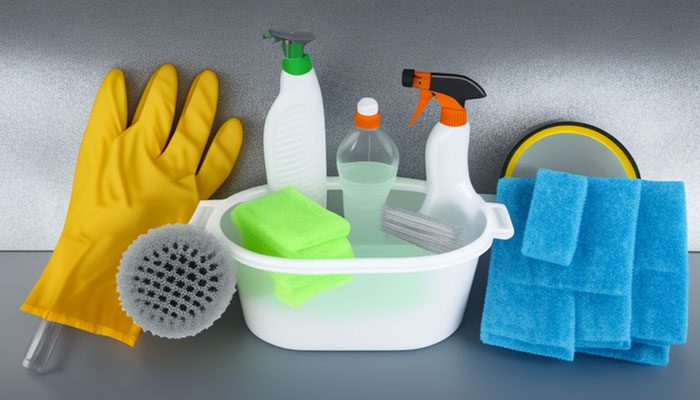
Step 2: Block the Tub Drain
Once you have gathered your supplies, it is time to block the bathtub drain path. This will help prevent the cleaner and any particles from entering your drainage system.
Several methods are available for doing this, such as using a stopper or covering the drain with plastic wrap.
Step 3: Wipe Off the Mortar from the Bathtub
After successfully blocking off the drain path, it’s time to start wiping off the fresh mortar from bathtub surfaces. Start by wetting down a microfiber cloth with warm water and wringing out excess moisture.
Then gently wipe away all of the loose mortar, taking care not to scratch or otherwise damage surfaces in the process. You can also clean grout and shower tile this way.

Step 4: Collect the Mortar
Once you’ve wiped away as much of the mortar as possible, it’s time to collect what’s left. You can use a dustpan and brush or a vacuum cleaner with a hose attachment.
Be sure to collect all the mortar so that none is left behind. Once you’ve collected all the mortar, you can dispose of it according to local regulations.
Step 5: Clean the Bathtub
Now that all of the mortars have been removed, it is time to clean the bathtub itself. Begin by unblocking the drain path and wetting the tub with warm water. To clean your bathtub, use a commercial cleaner.
When using the commercial cleaner for your bathtub, be sure to follow the directions on the package.
Apply enough cleaner according to the manufacturer’s instructions, letting it sit for a few minutes before scrubbing with a non-abrasive sponge or scrubber. Rinse off any excess soap and water from the tub.

Always use an antibacterial spray after every cleaning session to ensure your bathtub stays clean and free of germs and bacteria. This will help keep your tub looking great and free of harmful bacteria that could lead to health issues.
Avoid using harsh abrasives when cleaning your tub, as they can cause scratches that are difficult to repair.
Step 6: Dry the Area with a Soft Cloth
Once you have finished cleaning your bathtub with a commercial cleaner, it’s also important to dry off any residual water. So there won’t be any spots after you’re done.
To do this, start by wiping down any surfaces where water may have collected during rinsing or from spraying down earlier with an antibacterial spray.
Use a clean, soft cloth or terry towel to avoid scratching up surfaces in case you missed any remaining soap residue during rinsing earlier.
After drying off each surface completely, use another soft cloth or paper towel for buffing purposes, if necessary, to give everything back its original shine.
Though this isn’t always necessary, depending on what type of cleaner you used and how much it dried out your tub’s surfaces during cleaning time earlier on.
How to Clean Dried Mortar Off Bathtub?
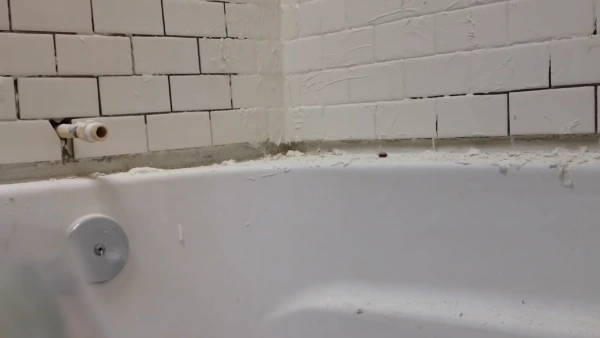
When cleaning dried mortar or hardened grout off a bathtub, the process is similar but requires a few extra steps. Follow the instructions below for the best results.
Step 1: Gather Necessary Supplies
When cleaning dried mortar off a bathtub, it is important first to gather all the necessary supplies. These include a wooden popsicle stick or tongue depressor, gloves, a cleaning solution, and a vacuum cleaner.
The popsicle stick should be used to scrape away the mortar stuck on the tub’s surface. Gloves should be worn to protect your hands from any debris and chemicals that may be on the surface of the dried mortar.
A vacuum cleaner should be available so you can suck up any remaining particles after scraping off the dried mortar from the tub’s surface.
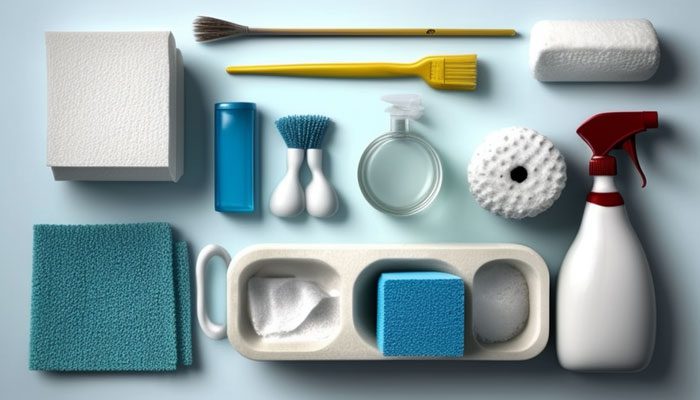
Step 2: Block The Bathtub Drain Path
Once you have gathered all of your supplies, it is essential to block off the bathtub drain path before beginning your cleaning process to avoid any stuff from clogging up the drains.
To do this, you can use rubber stoppers placed over each end of the bathtub drain opening. This will ensure that no particles accumulate in your pipes during the cleaning process.
Step 3: Pop-Off Dried Mortar Blobs
After blocking off the bathtub drain path, you can begin popping off dried mortar blobs using your tongue depressor or wooden popsicle stick.
First, put on a pair of gloves for protection and then carefully scrape away any hardened blobs on the tub’s surface using gentle pressure.

You may need to apply more pressure if some blobs are harder than others. It is essential not to press too hard so as not to damage your bathtub’s finish.
Step 4: Collect Loosened Pieces
Once you’ve popped off all of the dried mortar blobs, you will need to collect any remaining pieces or debris that have been loosened.
One tool that can help is a dustpan and brush. Using this combination, you can quickly gather up any remaining pieces without making too much mess.
It’s also important to double-check after collecting that no pieces have been left behind, as they are very hard to get rid of once they’ve settled into crevices in your tub’s surface.
Step 5: Vacuum the Bathtub
After you’ve collected all the dried mortar and grout dust pieces, vacuum up any residue. But be careful not to sweep up any debris, as this could scratch your bathtub surface.
Instead, use an upright vacuum cleaner with an attachment specifically designed for tiles and grout lines. This ensures maximum suction power while minimizing any potential damage to your bathtub’s finish.
Step 6: Make the Cleaning Solution
After vacuuming the dried mortar’s leftover particles from the bathtub, you need to clean the entire bathtub. There are many ways to make a bathtub cleaning solution.
The most common way is to mix baking soda and dish soap in equal parts and create a paste-like mixture. This will work to safely remove any residue from the bathtub left by the mortar removal process.

Another option is to use distilled white vinegar and dish soap combined for a similar effect. For those who don’t want to take the DIY route, there are many commercial cleaners on the market that also do an effective job of removing residue from the dried mortar.
It’s important to note that not all commercial cleaners are appropriate for use on bathtubs. Read labels thoroughly beforehand to ensure that you’re using something safe and non-abrasive for your particular surface type.
Step 7: Apply the Solution
Once you have selected your preferred cleaning solution, it’s time to apply it. To do this, begin by liberally spreading the paste or liquid cleaner over every inch of the affected areas using either a sponge or cloth.
Don’t forget to make sure that no spots are missed, as even small residues can affect how well the solution works overall. Once the entire area is covered, let the cleaner sit for at least 15 minutes before starting scrubbing.
Step 8: Wait, then Scrub
After waiting at least 15 minutes, it’s time to start scrubbing. Using either a sponge or nylon brush, gently begin scrubbing in circular motions over each area where you applied the solution earlier until all residue has been removed from view.
Be careful not to be too vigorous when doing this. Some surfaces may require only light pressure for them not to be damaged during this process.
Step 9: Rinse the Bathtub
Now that you have successfully removed all dried mortar residue from view with your cleaning solution and scrubbing efforts. It’s time to rinse off any remaining traces of cleaner and residue with warm water.
To do this effectively, start running lukewarm water over every inch of affected surfaces for everything to get washed away thoroughly.

Step 10: Dry the Area
Finally, dry off any remaining moisture with a soft cloth or towel so that no streaks remain on your clean bathtub surfaces afterward.
This will help ensure that future baths taken in these areas won’t be disturbed by any leftover traces of cleaner or residue left behind.
Additionally, if possible, try opening up windows or turning on fans nearby so that air can circulate more quickly. This helps evaporate remaining moisture faster than just drying alone.
Will Vinegar Soften Mortar for Bathtub Cleaning?
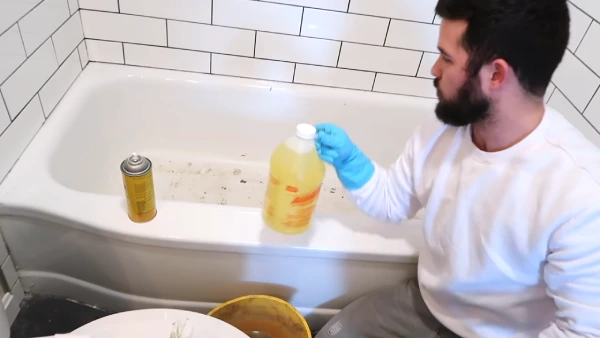
Vinegar is not strong enough to soften dried mortar. The cement that binds the mortar together is what prevents it from softening, and vinegar doesn’t have enough acidity to break down this bond.
It can be an effective cleaner that removes mortar stains but won’t soften the material itself. You can follow the steps outlined above for the most effective way of removing dried mortar from your bathtub.
Is Chlorine Bleach Safe for Removing Mortar Stains from the Bathtub?
Chlorine bleach can be used to remove mortar stains from fiberglass or white porcelain bathtubs, but it should be used cautiously and correctly.
Bleach is highly corrosive and can cause damage if not used safely. For maximum safety, it is recommended to mix ½ cup bleach into about a gallon of water before using it on your bathtub’s surface.
It’s essential also to wear protective gear like rubber gloves, goggles, and an old shirt when using bleach. Afterward, be sure to rinse off any remaining residue thoroughly before use.
What Dissolves Dried Mortar for Cleaning from the Bathtub?
Muriatic acid is a powerful chemical that can be used to dissolve dried mortar from most brick surfaces. Use muriatic acid with caution since it’s very corrosive and can irritate your skin and eyes.
When using muriatic acid to dissolve mortar from your bathtub, you should always wear protective gear such as gloves and goggles and work in a well-ventilated area.

Ensure any spills are cleaned up immediately to avoid contact with other surfaces or people. Also, it’s best to dilute muriatic acid with water before applying it directly onto your bathtub surface. This will help reduce the risk of damage while also ensuring you remove all traces of dried mortar.
Master Bathtub Mortar Removal: Easy Steps, Seamless Results
Removing mortar from your bathtub doesn’t have to be a difficult process. With the right supplies and following the above steps, you’ll be able to remove any fresh or dried mortar quickly and easily.
Remember that blocking the drain path is essential before starting so that no pieces of mortar get stuck in it.
Afterward, using a microfiber cloth or plastic scraper will help remove any fresh pieces of mortar, while cleaning solutions will help remove any dried-on pieces. Always make sure to rinse and dry the area completely before using it again.

